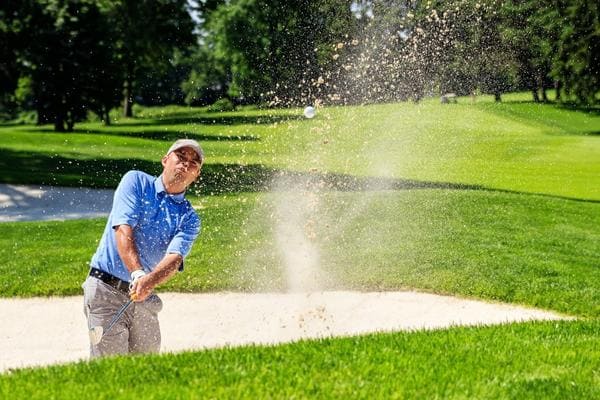Golf can be a peculiar sport at times, given the fact that you can actually play well, yet still score poorly and walk off the course annoyed.
Take basketball for example: if you take a shot and make a basket, it was a good shot.
If your shot misses, it’s a bad shot.
In golf, however, you might pipe a 300 yard drive only for it to take a harsh kick off the fairway and roll into a bunker, making it tough, and sometimes impossible, to reach the green in two.
This is why course management is so vital, given that, in golf, good shots can still lead to poor results, so being able to think your way through a round is a crucial skill for any player to have.
Golf management is important because even well executed shots can hurt your score if poorly thought through. Avoiding hazards and playing to the back of greens can help you stay on the short grass more often. Given amateurs have such difficulty with recovery shots when missing greens or fairways, simple considerations like this can have a large impact on lowering your scores.
There’s no simple recipe to good golf course management, rather a number of strategies and thought processes you can harness to try and play better golf.
We have outlined the 11 things to consider when it comes to golf course management that we think will have the biggest impact on getting your scores down without much effort at all.
But first, let’s take a quick look at what course management actually is, and why it’s super important to your success as a golfer.
Table of contents
What is course management in golf?
Course management in golf is the process of making good decisions during a round that will lead to the best-possible outcomes, produce the lowest possible scores and guard against compounding errors. This can include club choice; picking the correct target; or shot selection.
Good course management can be implemented by all golfers – regardless of whether you’re a beginner or professional – and can lead to significantly lower scores by reducing errors and giving you the best possible chance at success.
An example of good course management could be choosing to hit a mid-iron off the tee when faced with a tight out of bounds along the fairway, rather than driver.
Another example could be pitching out of the rough onto the fairway, rather than trying to pull off a 1-in-100 shot by hitting your ball through a tiny gap in the trees (which will, more often that not, lead to wasted strokes).
How important is course management in golf?
Course management is extremely important for golfers as it significantly reduces their chances of wasting strokes per round. The process of course management helps players identify risk and make decisions based on whichever shot is likely to give them the highest-percentage chance of success.
Essentially, good course management means having a clear, easy-to-follow strategy – and by putting it in place, it makes it harder to deviate from this strategy when things start going bad during a round.
For example, if you’ve just come off back-to-back bogeys and are faced with a short Par 4, your frustration may tempt you to try and hit driver rather than sticking to your original plan of hitting iron.
If your course management strategy is clear, it will help you cast aside irrational thoughts (like hitting driver when you’re angry) and make better decisions (like hitting iron as you’d originally intended) which will usually lead to improved results.
How to improve your course management in 11 steps
1. Take more club
Next time you play a round at your local course, take a few moments to observe where most of the hazards and bunkers are around the greens.
As a general rule, hazards will be far more plentiful at the front of greens, rather than the back, a simple law of golf course design brought about purely because of the way we as amateurs play.
Unfortunately, the PGA tour fills our heads with all sorts of fantasies about sending a 7 iron 180 yards, and this translates to over ambitious estimates of our own abilities each weekend.
So many players fail to acknowledge the amount of club they need to carry a bunker, or choose a club that requires an absolute ten out of ten strike to get it onto the putting surface.

Given the average player struggles so much from the sand, it makes far more sense to take an extra club, clear everything comfortably and have a putt from 10 yards past the hole, rather than a second from the bunker.
This applies to tee shots too, with players far too often eying off that pot 180 yards away with a belief their 5-wood will carry.
On a warm day with a tailwind perhaps you will, but if there’s any doubt in your head about your distance and the landing area is ample, take driver and know you have the journey, improving your chance of an approach played from the short grass.
2. Use a golf watch or rangefinder
Much of golf course management depends on your awareness of distances to carry bunkers, water and swales around the greens and being able to make good choices based upon this information.
This is why every golfer should have a good quality rangefinder or golf watch to ensure they never fall into the trap of thinking a 150-yard carry is actually 165 and playing a good shot that leads to a poor result.
I personally game the Sure Shot 5000 IP and find it to be great value for money, but it doesn’t have the full set of features of something like a Bushnell that can adjust for elevation.
I also game a Garmin Vivoactive 4 which is a superb all round smart watch with great golfing functionality, but the Garmin Approach range is probably a better option if you are truly golf obsessed.
Either way, a rangefinder is an absolute must for any golfer, and a golf watch is something worthy of solid consideration as well to help inform better choices on the course.
3. Avoid hazards off the tee
Biting off more than you can chew or taking overly high risks can be pure madness in golf, given how hard it is to make good contact off the fairway, let alone the rough or a waste bunker.
The first thought every person should have on the tee is ‘how do I find the fairway and not a bunker’, then club selection occurs as a result of the answer.
If all of the trouble is up the left, then play to the right, even if this means a tougher route to the green.

Unfortunately this is how course architects will design holes, making the best line in guarded by bunkers, tempting the naïve golfer to outperform the designer’s guile.
You’re far better off taking the safer path off the tee where you might need to play an approach just short of the green, but if you have confidence in your short game, par could still be on the table.
Yes a great drive might set you up for a birdie tilt, but taking on a bunker that might need two attempts to get out of sets you on a path to double town, so why risk it in the first place?
4. Miss greens in the right places
Course routing can allow for many devious defenses to be employed by greenskeepers on any given day, with the location in which they cut the hole bringing hazards into play or allowing a fairly gentle approach, depending on their mood.
For the amateur golfer, the real key is identifying the situation were the hole is a safe play versus when it should be avoided at all costs.
Rather than pin seeking every time, assess the hazards involved such as bunkers, swales or drop offs and consider whether you are comfortable playing your next shot from their if you don’t stiff your approach.
If you’re anything like me then you want to avoid tough up and downs at any cost, so aiming towards the part of the green that is least protected will be far less damaging if you miss your mark.
If you miss a green left where the fringe is flat and tightly mown, you may well be able to putt anyway.
Compare this to attacking the pin on the same hole and missing right where there is a steep drop off that runs towards a pond, well, it should be a no brainer which is the better play.
Since average golfers generally have a large fear of high lofted wedges around the greens – given they are so easy to knife through everything – missing towards the flattest part of the green complex will give you a chance to play a bump and run or even utilise your chipper, a far less stress inducing proposition.
5. Embrace a chipper or bump and run
Further to the point above, if you miss in the right places around greens then you’ll be able to play far easier chip shots without having to loft up or open club faces, things most amateurs golfers fear.
If you do have a nice, clear, relatively flat chip up to the putting surface, a little 7-iron bump and run or even a chipper can be far more effective and stress free than tackling the same shot with a 60.
Chippers do get a bad rap – golf and pride still goes hand in hand – but more and more golfers, even good quality ones, are opting for something like the Square Strike chipper for these tight lies around the greens.
Now admittedly I am still struggling to commit to a chipper – yes, I should put my pride aside – but the results do speak for themselves with thousands of golfers swearing by them, so if you can leave the ego at home then chucking one in the bag might do wonders for you.
6. Keep out of bunkers
There’s no denying that many amateurs see their bunker play as the weakest part of their game, with even a simple bunker shot from a nice lie posing the risk of needing three stabs to find the fairway or putting surface.
Whether this is from poor technique, lack of confidence or a failure to accelerate through the ball, unless you put in considerable time to rectify your bunker woes, keeping away from them altogether is going to serve most people well.
Generally, a chip shot from the fringe is going to be far more playable than a bunker shot, especially if it comes to rest in a poorly raked trap or a footprint.

For a lot of people, just getting out of the bunker in one is success, even if it leads to a 20 footer that results in a three putt.
If you stay clear of the bunkers on the right and miss to the safety of a flat fringe area on the left, you’ll probably have a good shot at getting your chip to three feet for an up and down, a stark contrast to hacking around in the pot burning shots.
Fairway bunkers are also great for heavy shots where the player fails to get ball first, advancing it only 30 yards down the fairway and leaving a long third in to a par four.
If you want to improve your course management and, with it, your scores, it would be hard to argue that anything on this list is more important than the need to stay away from bunkers.
7. Learn to use hybrids
Yet another symptom of the PGA tour being fed onto our screens each week is the myth perpetuated that any golfer can hit a stinging 2-iron or booming driver with ease.
While many solid amateur golfers will have a fantastic driver or high quality long iron shots, they can also be the most damaging clubs in the bag for others.
Rather than trying to pull off miracle plays with low lofted long irons, give real consideration to gaming hybrids below around a 5-iron.
The extra forgiveness will help you escape the rough and launch the ball at what is most likely lower swing speeds than tour players.
Where hybrids become a real course management weapon though is off the tee, as, despite their reduced distance, they can be far easier and more reliable to hit straight than a driver.
If you can learn to play a hybrid straight, you’ll have way more approaches from fairways, rather than hazards and bunkers, which, as I discussed earlier, can be absolute round killers.
Try gaming something like the Apex Hybrid from Callaway with an adjustable sleeve that allows you to tinker with loft.
8. Use a tee on Par 3s
While it may seem glamourous to pure an 8-iron off the deck into a par three with a pristine divot, as amateur golfers, we need to embrace all of the help we can get.
We only get 18 opportunities, outside of putting, where we can control the lie of the ball, and for most golfers, teeing the ball up even if only slightly on a Par 3 is going to be far more forgiving than going off the deck.
You see, us mere mortals have a real fear of hitting down on the ball, and I personally find that, on par threes, I still fall into the trap sometimes of feeling like I need to hit up on the ball to get it sky high and stopping quick.

Now this is clearly wrong, but the mind can be hard to tame in golf.
This is why a tee is so important, as a downward strike on a ball perched slightly off the ground will still come out beautifully.
However, that quarter inch buffer that a tee provides can make a huge difference for strike with a positive attack angle, so it is an absolute no brainer to prop your ball up a tad on all of the short holes.
9. Believe your next shot will be a good one
This relates really closely to the tendency we have to compound errors by hitting a bad shot, then biting off more than we can chew with the next one.
Say I hit a 200 yard drive into the right trees, leaving myself 170 yards to the green.
Now I could try and thread one through the trees and roll up onto the green, but the likelihood of pulling this off is probably 1 in 10.
The other option is to advance the ball sideways, getting about 20 yards closer to the hole.
I regularly get caught in the first mindset, often because I worry that the punch out to 150 still leaves me with a tricky approach.
However, a 150 yard shot in for your third from the middle of the fairway is still better than the 9 in 10 prospect of you not being able to thread the needled and rattling around in the trees, just to end up in the same position you started.
I think it’s crucial for us to have confidence in our game and play as if a good shot is around the corner, because there’s every chance that it will be. In this situation, if I punch out believing my 150 yard approach will be a good one, and it is, I’m looking at a potential green hit and two putt bogey.
Compare this to three hacks in the trees then an approach into the green for five and you might have just caused that blow up triple that causes your round to fall to pieces.
10. Clean your grooves before each shot
A quick and easy tip, but one that far too many golfers ignore: clean your club grooves before every shot.
The grooves are there for a reason, and if they are full of sand, mud and grass, they won’t impart anywhere near the full amount of spin on your shots.
Given course management is about thinking your way through your round and making small, good decisions from start to finish, remembering this simple habit can save you a few shots each time you play.
If you have a cleaning brush and a towel that clips onto your bag they will always sit there in plain sight, a visual reminder to keep wiping down those clubs and cleaning your grooves before the club goes back in the bag.
11. Learn to lay up
It’s certainly hard to keep the ego at bay when playing golf, especially in a group of four buddies, but making conservative decisions on course is a recipe to lower scores.
Ultimately, the scorecard is all people are going to talk about when you’re collecting their money post round in the clubhouse.
While you might be able to get the ball inside 200 with your drive on a par five, this doesn’t mean it should be an automatic green light to have a lash in two.
Acknowledging when the danger, such as bunkers and water hazards, poses a real risk to dropped shots and poor holes, taking your medicine and laying up short of trouble might not yield an eagle putt, but it could put you in range to pitch one close for a birdie.
So rarely do I see even the best scratch golfers I play with hit greens in two and make eagle putts, so what’s the point in risking a triple by trying to carry water 200 yards away into a head wind?
This is where even the pros make good decisions based on conditions and course set up, with the 17th at St Andrews, known as the road hole, a perfect example.
So often players will drive the ball into the left rough, staying away from the out of bounds hotel on the right, only to play a second shot approach to 10 yards short of the green.
From here they back themselves in to get up and down by avoiding the road hole bunker, known for churning out double bogeys with its 6 foot high face.
If the pros can understand that there’s times were caution is necessary, it’s a skill worth developing yourself, too.
Final message
Course management may not excite many golfers and is unlikely to lead to miraculous shots that are talked about by your playing group for years to come, but what it will lead to is lower scores, less frustration and a greater feeling of control out on the course.
By clubbing up, knowing your limits and making some better decisions, you can lower your score considerably without needing to make any changes or improvements to your swing.


